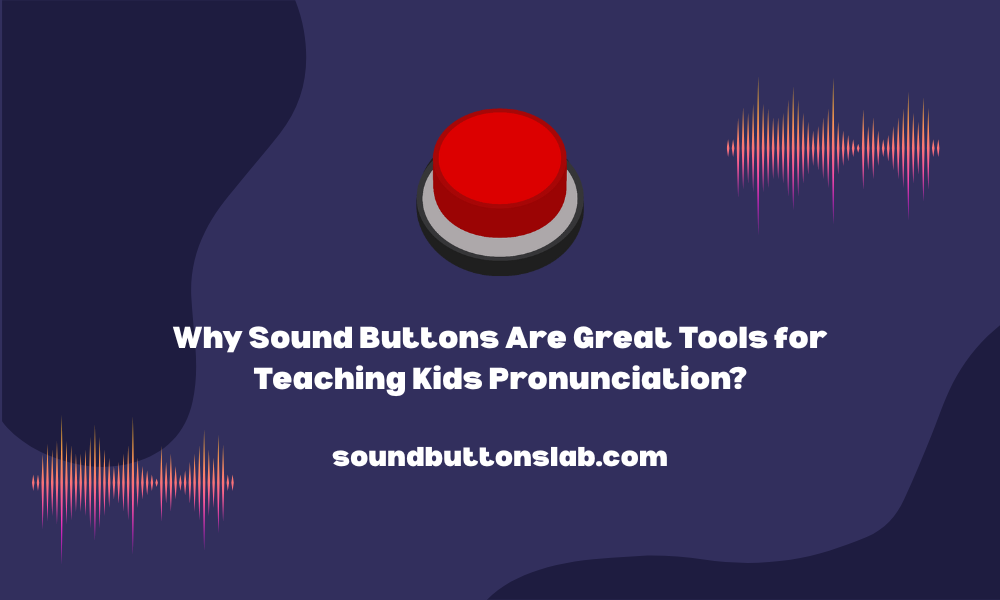Helping kids learn pronunciation can be a challenge, especially when they are just starting to develop their language skills. Many traditional methods, like flashcards and repetition, can feel boring or frustrating. This is where sound buttons come in.
These interactive tools make learning fun and engaging, allowing children to hear, practice, and perfect their pronunciation in a way that feels like play. Sound buttons are effective and enhance language learning.
How Sound Buttons Help with Pronunciation
Sound buttons simplify the process of learning pronunciation for young learners by providing immediate feedback, allowing them to hear the correct pronunciation instantly and self-correct if needed. They also enable repetition, a key component of learning, by letting children hear the same word or sound multiple times until they feel confident.
Sound buttons can also be used to teach phonics, which is the relationship between letters and sounds. For example, a phonics toy might have buttons for different letter sounds. When the child presses the button for “B,” they hear the “buh” sound, helping them understand how the letter is pronounced.
Moreover, the interactive nature of sound buttons transforms pronunciation practice into a fun and engaging experience, keeping kids motivated and enthusiastic about learning.
Why Sound Buttons Are Great Tools for Teaching Kids Pronunciation
1. They Make Learning Interactive and Fun
Traditional methods of teaching pronunciation, like repeating words after a teacher, can get boring quickly. Sound buttons, on the other hand, add an element of play to the learning process. Kids love pressing buttons and hearing sounds, which makes them more likely to stay engaged and practice longer.
For example, a child learning the word “cat” might press the sound button repeatedly to hear the word and the “meow” sound. This playful interaction keeps them interested and encourages them to keep practicing.
2. They Provide Clear and Accurate Pronunciation
One of the biggest challenges in teaching pronunciation is ensuring that kids hear the correct sounds. With sound buttons, you don’t have to worry about mispronunciations or accents interfering with the learning process. The pre-recorded sounds are clear and accurate, providing a reliable model for kids to follow.
This is especially helpful for non-native English speakers or parents who may not feel confident in their own pronunciation skills. Sound buttons act as a consistent and trustworthy guide.
3. They Cater to Different Learning Styles
Every child learns differently. Some are visual learners, while others are auditory or kinesthetic learners. Sound buttons cater to all these styles by combining:
- Visual Learning: Seeing the word and the associated image.
- Auditory Learning: Hearing the correct pronunciation.
- Tactile Learning: Pressing the button to activate the sound.
A sound button device with everyday objects can help kids learn new words. For instance, pressing the button for “umbrella” plays the word and a sentence like, “I use an umbrella when it rains.” This not only teaches pronunciation but also expands vocabulary.
4. They Build Confidence
Pronunciation can be intimidating for kids, especially when they’re just starting out. Sound buttons help build confidence by allowing children to practice independently. They can press the button as many times as they need to feel comfortable with a word, without fear of judgment or embarrassment.
This sense of independence and mastery encourages kids to take risks and try new words, which is essential for language development.
5. They Encourage Active Participation
Unlike passive learning methods, such as listening to a teacher or watching a video, sound buttons require active participation. Kids have to press the button, listen carefully, and repeat the sounds. This active engagement helps reinforce learning and improves retention.
For example , a sound button book about animals might have buttons for different animals. When the child presses the button for “lion,” they hear the word “lion” and the sound a lion makes. This helps them associate the word with the correct sound and pronunciation.
How to Use Sound Buttons Effectively
To use sound buttons effectively, start with simple, familiar words to build confidence, then pair them with pictures or sentences to provide context, such as showing a picture of an apple and using it in a sentence. Encourage repetition by having your child press the sound button multiple times and repeat the word out loud, turning it into a game to master pronunciation.
Combine sound buttons with other learning tools, such as flashcards, books, or apps, to reinforce new words and skills, creating a comprehensive learning experience that fosters engagement and progress.
Conclusion
Sound buttons are a valuable tool for teaching kids pronunciation, offering a range of benefits, from improved phonemic awareness to increased confidence. By incorporating sound buttons into your teaching practice, you can provide children with a fun and engaging way to develop essential pronunciation skills. Whether you're a parent, educator, or speech-language pathologist, sound buttons are definitely worth exploring.
